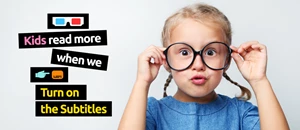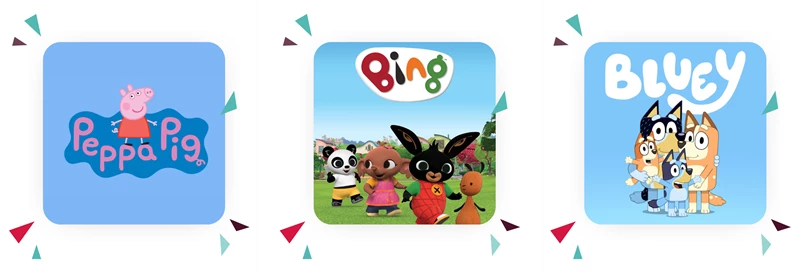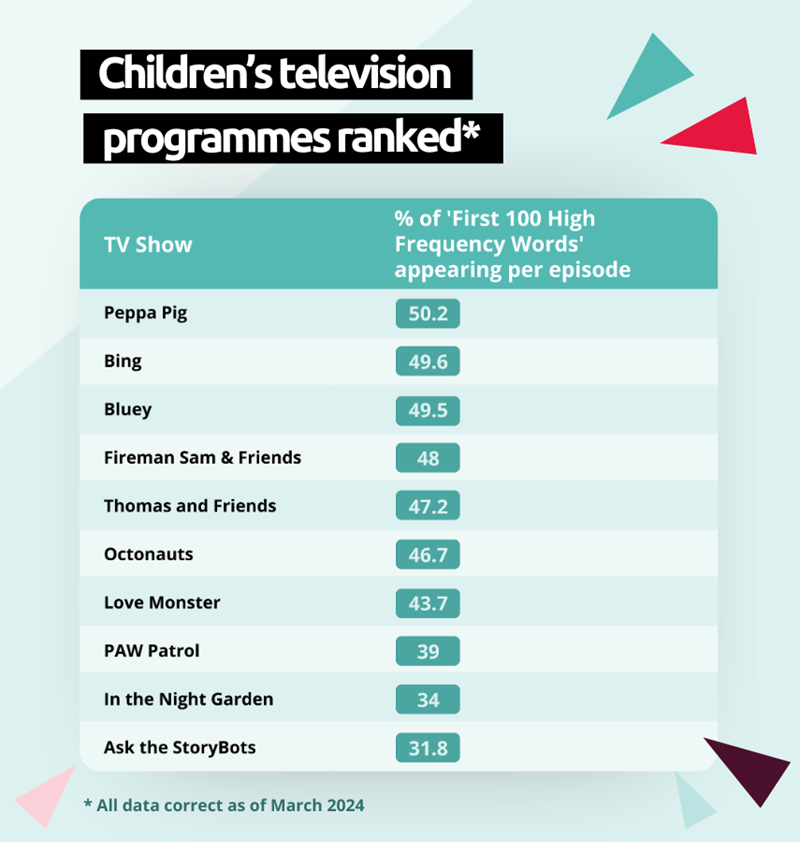Which television shows could help to improve your child's literacy levels?
With children in the UK reported to be spending an average of 3 hours and 16 minutes watching television every day, parents will be pleased to know that some of the UK’s favourite children’s television programmes could actually be doing wonders for their children’s literacy levels, helping to ease the perceived guilt around too much screen time.
We analysed the transcripts of over 1,000 episodes of children’s television programmes aimed at those between the ages of four and seven to see which, on average, contains the highest volume of basic phonics words that children are expected to know by the end of Key Stage One.

Top 3 shows to watch with subtitles
The research revealed that shows like Peppa Pig, Bing and Bluey could help children to become more confident in their reading, and, if watched with the subtitles, could double the chances of children leaving school as proficient readers.
Access Education is committed to supporting schools to improve parent engagement through providing software that makes communication and progress tracking as easy as possible. Parent communication platforms can help parents to stay in the loop and be instantly updated on their children’s learning journey, which is especially important for children in early years education.
The television show that came out on top in the research when it came to having the highest volume of basic phonics words was the nation’s favourite pig - Peppa.
It was found that, on average, over 50% of words in an episode of Peppa Pig can be found on the widely used phonics resource ‘First 100 High Frequency Words’[1], making it a brilliant choice for children who are preparing to start school and starting out on their reading journey.
Second on the list was Bing, with an average episode transcript being made up of 49.6% words from the phonics list. The whimsical and fun world of Bing Bunny has been praised for always ending with a positive message, and its easy-to-follow storylines make it a great choice for EYFS children.
Next on the list with 49%, is Bluey, an Australian cartoon that has become globally popular with children and adults alike. Research shows that Bluey has an average daily reach of 5.3million with children aged five plus in the UK - making it one of the most popular television shows for children in Key Stage One.
Most frequent words
Unsurprisingly, the words with the highest volume of usage across all of the television shows analysed were the articles and prepositions ‘the’, ‘and’, ‘a’ and ‘to’. Understanding these basic words is fundamental when it comes to children being able to begin constructing grammatically correct sentences and having an understanding of how words function in sentences, leading to improved language skills.
For children who are learning phonics in school, hearing and seeing these words on screen can help to accelerate understanding. And, for older children, watching these television shows can still be beneficial for reinforcing knowledge of basic vocabulary.
Aside from these more basic words, one word that was in the top five most frequent across all television shows analysed, was the word ‘oh’. In children's television, where emotions and reactions are often exaggerated for emphasis, the word ‘oh’ is a handy tool for expressing feelings that can resonate with the audience.

Least frequent words
Words that appeared less frequently across these television programmes appear later on in the list, meaning that they are more difficult to comprehend and less likely to be used within the more basic narrative worlds of children’s television. Words such as ‘make’, ‘them’, and ‘put’ were often not used at all in the episodes analysed.
The research showed that the language in these shows tends to be in the present tense which was reinforced by the least common word across the board being ‘looked’. The combination of the ‘oo’ sound and the ‘-ed’ ending of this word can make it challenging, particularly for children in the early stages of reading and phonics.

In the Night Garden had the second fewest basic words, however this could be due to the fact that the show uses a lot of nonsensical words that mirror baby babble to calm and relax younger viewers before bedtime, which is the premise of the show.
American programme Ask the StoryBots had the fewest basic phonics words on average per episode of those analysed. The cartoon which seeks to answer a different question each episode such as ‘why is the sky blue?’ and ‘why can’t I eat dessert all the time?’ uses more complex language and whilst it is educational, it may be harder to follow for younger viewers.
The report has been conducted in partnership with Turn on the Subtitles (TOTS), an educational initiative that exists to help improve children’s literacy through the power of good quality subtitles. TOTS is working in collaboration with organisations like GCSEPod, leading charities and universities aiming to encourage broadcasters, policymakers, and parents to embrace the subtitles strategy.
Commenting on the findings, Henry Warren, early years education expert and co-founder of TOTS, said:
“Whilst it's undeniable that children are spending more time attached to screens, this research proves that this time can be educational. Turning on the subtitles can give children an opportunity to increase their vocabulary knowledge and help turn them into proficient readers.
“If you turn on the subtitles, then in just a year kids would ‘read’ the same number of words that are in all the Harry Potter, Narnia and Lord of the Rings books as well as everything Roald Dahl wrote, combined - it’s an impressive amount of words!
“I co-founded TOTS because I have three young children and what we’re trying to achieve really resonated with me. TOTS is one of those ‘no brainer’ ideas that can really help us as parents. I like to think of it a bit like sneaking vegetables into dinner, the children don’t notice, but you know you’re doing them the world of good.”
Methodology
To identify which children’s television programmes had the highest average number of ‘First 100 High Frequency Words’, Access Education obtained transcript data for 10 episodes of each show, analysing how many times each of the 100 words from the list appeared per episode. The average episode length was based on data taken from YouTube.
Find out how you can spread the word in your school: Turn On The Subtitles | Access Education
[1] ‘First 100 High Frequency Words' is a resource that is widely-used in schools in the UK as part of the ‘Letters and Sounds’ phonics model.




